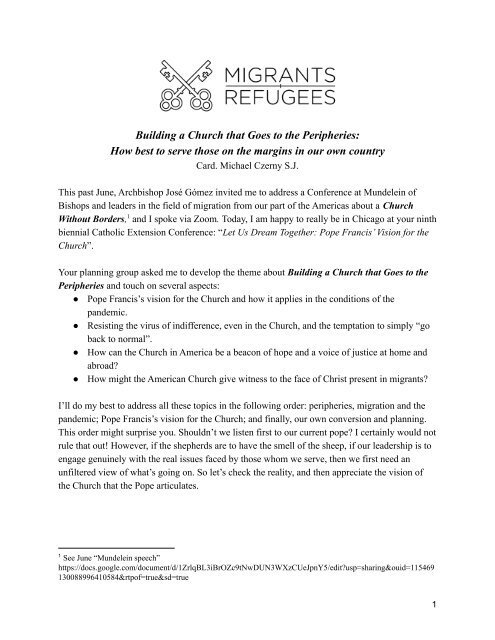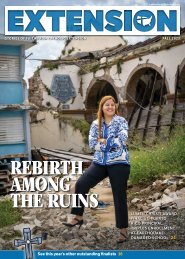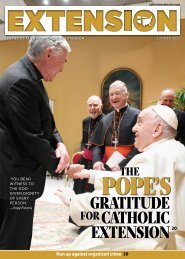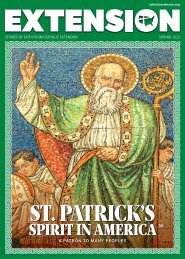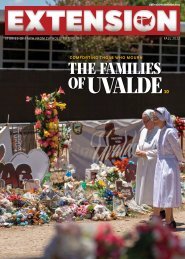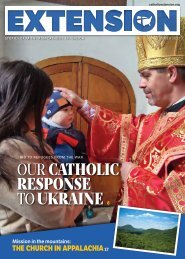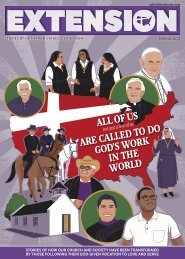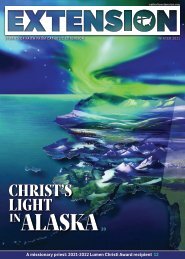Cardinal Michael Czerny, S.J., Message on Migrants
Many thanks to Cardinal Michael Czerny, S.J., the Holy See's Under-secretary for the Dicastery for Promoting Integral Human Development, for his presentation to the bishops of Extension-supported dioceses.
Many thanks to Cardinal Michael Czerny, S.J., the Holy See's Under-secretary for the Dicastery for Promoting Integral Human Development, for his presentation to the bishops of Extension-supported dioceses.
Create successful ePaper yourself
Turn your PDF publications into a flip-book with our unique Google optimized e-Paper software.
Building a Church that Goes to the Peripheries:<br />
How best to serve those <strong>on</strong> the margins in our own country<br />
Card. <str<strong>on</strong>g>Michael</str<strong>on</strong>g> <str<strong>on</strong>g>Czerny</str<strong>on</strong>g> S.J.<br />
This past June, Archbishop José Gómez invited me to address a C<strong>on</strong>ference at Mundelein of<br />
Bishops and leaders in the field of migrati<strong>on</strong> from our part of the Americas about a Church<br />
1<br />
Without Borders, and I spoke via Zoom. Today, I am happy to really be in Chicago at your ninth<br />
biennial Catholic Extensi<strong>on</strong> C<strong>on</strong>ference: “Let Us Dream Together: Pope Francis’ Visi<strong>on</strong> for the<br />
Church”.<br />
Your planning group asked me to develop the theme about Building a Church that Goes to the<br />
Peripheries and touch <strong>on</strong> several aspects:<br />
● Pope Francis’s visi<strong>on</strong> for the Church and how it applies in the c<strong>on</strong>diti<strong>on</strong>s of the<br />
pandemic.<br />
● Resisting the virus of indifference, even in the Church, and the temptati<strong>on</strong> to simply “go<br />
back to normal”.<br />
● How can the Church in America be a beac<strong>on</strong> of hope and a voice of justice at home and<br />
abroad?<br />
● How might the American Church give witness to the face of Christ present in migrants?<br />
I’ll do my best to address all these topics in the following order: peripheries, migrati<strong>on</strong> and the<br />
pandemic; Pope Francis’s visi<strong>on</strong> for the Church; and finally, our own c<strong>on</strong>versi<strong>on</strong> and planning.<br />
This order might surprise you. Shouldn’t we listen first to our current pope? I certainly would not<br />
rule that out! However, if the shepherds are to have the smell of the sheep, if our leadership is to<br />
engage genuinely with the real issues faced by those whom we serve, then we first need an<br />
unfiltered view of what’s going <strong>on</strong>. So let’s check the reality, and then appreciate the visi<strong>on</strong> of<br />
the Church that the Pope articulates.<br />
1<br />
See June “Mundelein speech”<br />
https://docs.google.com/document/d/1ZrlqBL3iBrOZc9tNwDUN3WXzCUeJpnY5/edit?usp=sharing&ouid=115469<br />
130088996410584&rtpof=true&sd=true<br />
1
That’s why I follow the see-judge-act approach, which was initiated in the Young Christian<br />
Workers movement by Fr. Joseph Cardijn and has been carried forward by the Holy Fathers from<br />
St John XXIII to Pope Francis. It has us c<strong>on</strong>tinually ask:<br />
- What do we see, hear, experience?<br />
- What do we think, appreciate, judge?<br />
- How do we resp<strong>on</strong>d, plan, program?<br />
Short answer: we endeavor to see, judge and act according to Scripture, Traditi<strong>on</strong>, Vatican II, and<br />
Catholic Social Teaching.<br />
1. The existential peripheries<br />
On 9 March 2013, Archbishop Bergoglio of Buenos Aires c<strong>on</strong>cluded his electrifying 5-minute<br />
address to his fellow electors with the hope that the next Pope would be “a man who, through the<br />
c<strong>on</strong>templati<strong>on</strong> of Jesus Christ and the adorati<strong>on</strong> of Jesus Christ, may help the Church to go out<br />
from itself toward the existential peripheries, that may help it to be the fecund mother who lives<br />
‘by the sweet and comforting joy of evangelizing’.” It was to become a key generative image of<br />
Pope Francis’s magisterium.<br />
For example, in Evangelii Gaudium, Pope Francis used the word “periphery” seven times. But<br />
the English translator seemed allergic to the word, using it <strong>on</strong>ce in quotes (EG 20) and otherwise<br />
translating it as “outskirts” and “fringes”. Do either of these words help? This might seem an<br />
unnecessary worry but, since peripheries are hard for us to perceive, even harder to grasp, and<br />
really hardest to take resp<strong>on</strong>sibility for, I think the word is worth underlining. C<strong>on</strong>sider this<br />
statement: “Exclusi<strong>on</strong> ultimately has to do with what it means to be a part of the society in which<br />
we live; those excluded are no l<strong>on</strong>ger society’s underside or its fringes [periferias] or its<br />
disenfranchised – they are no l<strong>on</strong>ger even a part of it. The excluded are not the “exploited” but<br />
the outcast, the “leftovers”” (EG 53) And again: “All of us are asked to obey [the Lord’s] call to<br />
go forth from our own comfort z<strong>on</strong>e in order to reach all the “peripheries” in need of the light of<br />
the Gospel” (EG 20).<br />
In Fratelli tutti under the sub-heading “Open societies that integrate every<strong>on</strong>e”, Pope Francis<br />
gives us an existential reading of “peripheral”:<br />
Some peripheries are close to us, in city centers or within our families. Hence there is an<br />
aspect of universal openness in love that is existential rather than geographical. It has to<br />
do with our daily efforts to expand our circle of friends, to reach those who, even though<br />
they are close to me, I do not naturally c<strong>on</strong>sider a part of my circle of interests. Every<br />
brother or sister in need, when aband<strong>on</strong>ed or ignored by the society in which I live,<br />
becomes an existential foreigner, even though born in the same country. They may be<br />
2
citizens with full rights, yet they are treated like foreigners in their own country. Racism<br />
is a virus that quickly mutates and, instead of disappearing, goes into hiding, and lurks in<br />
waiting. (FT 97)<br />
As applied by Pope Francis to society, to certain people and places within the territory of each<br />
diocese (or of the whole Church in a country), “periphery” describes a people’s c<strong>on</strong>diti<strong>on</strong> and<br />
indeed suffering, but also identifies what an individual Christian or Christian community can<br />
perceive, appreciate, and resp<strong>on</strong>d to.<br />
No <strong>on</strong>e is useless, in the words of Fratelli tutti, and no <strong>on</strong>e is expendable. Each of us, moreover,<br />
can learn something from others. This means finding ways to include those <strong>on</strong> the peripheries of<br />
life. “For they have another way of looking at things; they see aspects of reality that are invisible<br />
to the centers of power where weighty decisi<strong>on</strong>s are made”. To represent a society or a Diocese<br />
“where differences coexist, complementing, enriching and reciprocally illuminating <strong>on</strong>e another,<br />
even amid disagreements and reservati<strong>on</strong>s”, Pope Francis proposes the image of a polyhedr<strong>on</strong><br />
and a new culture of encounter. (cf FT 215).<br />
II. Not migrati<strong>on</strong> but migrants<br />
I would guess that migrati<strong>on</strong> is an element in the pers<strong>on</strong>al or family history of most of you, if not<br />
all. Perhaps like me, some of you were children when your family switched c<strong>on</strong>tinents or at least<br />
countries. And of course, American history is shaped by different types of migrants, from<br />
hopeful early settlement by English col<strong>on</strong>izers, through the devastating African slave trade, all<br />
the way to the presence of migrant workers from Central America and Mexico, the current<br />
desperate new arrivals from Afghanistan, and the c<strong>on</strong>stant, fully understandable pressure <strong>on</strong> the<br />
southern U.S. border. Al<strong>on</strong>g the way, migrants have greatly c<strong>on</strong>tributed to the face of the Church<br />
here. Think of the Irish escaping the potato famine in the mid-19th century. And the Italian influx<br />
was so significant that the Scalabrinian order (or the C<strong>on</strong>gregati<strong>on</strong> of the Missi<strong>on</strong>aries of Saint<br />
Charles Borromeo) was founded in 1887 to serve the Italian diaspora. Happily, I have Fr. Fabio<br />
Baggio, a Scalabrinian, as my co-Undersecretary for <strong>Migrants</strong> and Refugees.<br />
Let’s turn to what is going <strong>on</strong> right now. How shall we, particularly as Bishops, regard the<br />
vulnerable people <strong>on</strong> the move within American diocesan territories? Their movement can take<br />
place in different directi<strong>on</strong>s: arriving and in transit; staying permanently or departing for good,<br />
perhaps to return to a previous homeland; or seas<strong>on</strong>al comings-and-goings. In your Diocese you<br />
can have several of these situati<strong>on</strong>s at the same time, or even all of them. I menti<strong>on</strong> this to<br />
suggest that, to begin taking hold of this pastoral challenge, the first thing we need is help to<br />
perceive accurately what is going <strong>on</strong>; or, in other words, to research, as in “searching for the lost<br />
sheep”.<br />
3
Very so<strong>on</strong> after the <strong>Migrants</strong> & Refugees Secti<strong>on</strong> began its work, Pope Francis addressed an<br />
internati<strong>on</strong>al forum <strong>on</strong> “Migrati<strong>on</strong> and Peace” and spelled out the four moments or dimensi<strong>on</strong>s of<br />
a shared, coordinated and effective resp<strong>on</strong>se in the form of four verbs: to welcome, to protect, to<br />
2<br />
promote and to integrate. His remarks reflected the sec<strong>on</strong>d phase in the see-judge-act<br />
methodology – thinking, interpreting and understanding as genuinely as possible so as to judge<br />
fairly and prudently – and doing this in the interests of the third phase, namely to guide acti<strong>on</strong>.<br />
Here is some explanati<strong>on</strong> of these verbs, which take <strong>on</strong> added significance when applied to<br />
another c<strong>on</strong>text such as the COVID pandemic.<br />
1) The obvious first step is to welcome those who are in flight, in jeopardy, in need of a new and<br />
better place. It’s as obvious as the Statue of Liberty with its w<strong>on</strong>derful welcoming poem about a<br />
new home for the homeless, about relief for the tempest tossed. It can be as simple as finding a<br />
traveler at your door, as in many Bible stories; it can also be very complicated in our modern<br />
administrative procedures.<br />
In Catholic Social Teaching terms, we can link welcoming to the virtue of solidarity—the noti<strong>on</strong><br />
that we are all resp<strong>on</strong>sible for all, not just people within our own borders. Those borders can be<br />
nati<strong>on</strong>al fr<strong>on</strong>tiers, but also the dividing lines between adjacent communities – think of the people<br />
from the so-called ‘wr<strong>on</strong>g side of the tracks’.<br />
Let’s think for a moment about all those borders. They are human c<strong>on</strong>trivances, and we have to<br />
be careful. God did not draw those lines. And since the publicati<strong>on</strong> of the USCCB’s pastoral<br />
3<br />
letter <strong>on</strong> racism in 2018, "Open Wide Our Hearts: The Enduring Call to Love”, the Dioceses<br />
have redoubled efforts to identify and overcome borders of race and structures of supremacy.<br />
2) Sec<strong>on</strong>d, the requirement to protect reflects the complex reality facing people in the midst of<br />
major changes. They may have difficulty escaping an oppressive past. They may be easily<br />
c<strong>on</strong>fused or lost in unfamiliar surroundings. As we have seen in our migrant and refugee<br />
research, unprotected new arrivals can become ensnared in human trafficking. And as some of<br />
you undoubtedly have seen, it can be as difficult and dangerous to cross from <strong>on</strong>e side of town to<br />
the other in some places, as it is to cross internati<strong>on</strong>al borders in some places. There can be a<br />
propensity for ‘us’ to be suspicious of ‘them’, be they newcomers from foreign lands or the other<br />
side of town or the state or the country. In that atmosphere, and with the tendencies towards<br />
loudly expressed anger and even physical violence, it is vital to stand up for ‘them’ and protect<br />
them.<br />
3) Third, to promote reflects a fulsome respect for human rights, which in turn flows from the<br />
inherent dignity of every human being. What rights, what dignity? Clearly it’s more than the<br />
2 Pope Francis, Address to the Internati<strong>on</strong>al Forum <strong>on</strong> “Migrati<strong>on</strong> and Peace”, 21.02.2017.<br />
3<br />
https://usccb.org/issues-and-acti<strong>on</strong>/human-life-and-dignity/racism/upload/open-wide-our-hearts.pdf<br />
4
absence of unjust c<strong>on</strong>straints and absence of threat, which are addressed by welcome and protect,<br />
In the famous formulati<strong>on</strong> of Erich Fromm, those have to do with “freedom from.” This is<br />
completed by “freedom to”, that is, the c<strong>on</strong>diti<strong>on</strong>s under which humans can blossom and<br />
flourish.<br />
You have probably supported this sort of promoti<strong>on</strong> within your Dioceses: programs designed to<br />
help kids and adults to develop themselves, to achieve more in their educati<strong>on</strong> and work. It<br />
applies to migrants too, beginning with the right to migrate in times of need. As St. John XXIII<br />
stated in Pacem in Terris, “am<strong>on</strong>g man's pers<strong>on</strong>al rights we must include his right to enter a<br />
country in which he hopes to be able to provide more fittingly for himself and his dependents. It<br />
is therefore the duty of State officials to accept such immigrants and—so far as the good of their<br />
own community, rightly understood, permits—to further the aims of those who may wish to<br />
become members of a new society.” That is, the aim of flourishing for <strong>on</strong>eself and <strong>on</strong>e’s family<br />
must be accommodated or promoted, not blocked.<br />
The undeniable right of every human being to pers<strong>on</strong>al development calls for the promoti<strong>on</strong> of<br />
integral human development — the fullest development of each pers<strong>on</strong> and all people, allowing<br />
them to become active agents of their own development. In the case of migrants and refugees,<br />
this applies in countries of origin as well as places of transit, and destinati<strong>on</strong>. Before the right to<br />
migrate, states should guarantee the right not to have to migrate. All people must have the right<br />
to remain in their homelands, living lives of dignity, peace, and security. This might be relevant<br />
to your Diocese. Are some people leaving or thinking of doing so? How can we make the local<br />
community a place of real flourishing such that our people d<strong>on</strong>’t chase off after ‘the bright city<br />
lights’ and ‘the streets paved with gold’ elsewhere?<br />
4) Finally, to integrate is both the fourth and the ultimate moment in the process. We all know<br />
what it means. A pers<strong>on</strong> who is truly integrated feels completely included; social distance has<br />
disappeared, psychological barriers have dissolved. As Americans, you know the immense<br />
importance of integrati<strong>on</strong> and the c<strong>on</strong>tinuing tragedies of segregati<strong>on</strong>. Whether we’re talking<br />
about people within this country striving for acceptance and fair opportunity or about newcomers<br />
seeking a better life, let us admit that if we welcome, protect and promote, the job is not finished.<br />
The last step is the beautiful but slow process of going from “them” to “us”, from dependents to<br />
full participants, from ‘objects’ of our generosity (or even legal resp<strong>on</strong>sibility) to fellow-citizens<br />
and, indeed, fellow-“integrators” to others.<br />
Another dimensi<strong>on</strong> of integrati<strong>on</strong> is mutual enrichment. Without our paying attenti<strong>on</strong> to it,<br />
integrati<strong>on</strong> is always a two-way process, based <strong>on</strong> openness, <strong>on</strong> appreciative encounter, and<br />
recogniti<strong>on</strong> of the other’s spiritual and cultural richness. It’s that marvelous two-way movement<br />
from knowing about <strong>on</strong>e another, to actually knowing <strong>on</strong>e another; from helping other people<br />
5
meet their needs, towards the care of kith and kin. To integrate aims ultimately at friendship.<br />
That is the blessed state that Pope Francis c<strong>on</strong>stantly encourages every<strong>on</strong>e to pursue.<br />
Welcoming, protecting, promoting and integrating apply to engagement with all the peripheries.<br />
The insight comes from migrant and refugee work but it applies to making our society right for<br />
people with disabilities, to overcoming barriers against full inclusi<strong>on</strong> of minorities, to<br />
overcoming intergenerati<strong>on</strong>al poverty in our cities and so <strong>on</strong>. I would be grateful to hear your<br />
examples. Even if your Diocese is not <strong>on</strong> the border, there are vulnerable people <strong>on</strong> the move<br />
throughout U.S. society, but -- typical of people <strong>on</strong> the periphery -- they’re usually invisible. So<br />
the first step, in each Diocese, is to see them, encounter them, share their experience and<br />
eventually take a few steps in their shoes.<br />
I hope you can take a shared approach in your work with migrants and refugees. The “borders”<br />
are everywhere throughout the U.S.A. -- yes, al<strong>on</strong>g the Rio Grande, and there are also vulnerable<br />
people <strong>on</strong> the move hiding, stuck, invisible in every diocese, including the “Extensi<strong>on</strong>” <strong>on</strong>es. As<br />
they move from Haiti, Central America and elsewhere, through Mexico and into the United<br />
States, they shouldn’t feel like they’re moving through different churches but within <strong>on</strong>e<br />
“borderless” Church. They should experience, as much as possible, a c<strong>on</strong>tinuity of pastoral<br />
accompaniment and care: welcomed <strong>on</strong> arrival and protected, promoted and integrated there, or<br />
if moving <strong>on</strong>, sent to another welcoming community of <strong>on</strong>e and the same Church.<br />
III. The Pandemic<br />
The <strong>on</strong>-going Covid-19 emergency has been testing the physical, mental and social endurance of<br />
entire nati<strong>on</strong>s. Like a magnifying glass, it has revealed the weaknesses of social organizati<strong>on</strong> and<br />
the vulnerability of many people.<br />
Running up against our worldwide vulnerability without excepti<strong>on</strong>s, has been a real shock; and<br />
we’ve been surprised at the dramatic evidence of our interdependence. This has occurred in the<br />
c<strong>on</strong>text of suffering and fear. Pope Francis captured this in his Urbi et Orbi homily <strong>on</strong> 27 March<br />
2020, barely a m<strong>on</strong>th into the pandemic. Quoting the Gospel of the Storm at Sea (Mark 4:35-41),<br />
the Holy Father gave deep-felt expressi<strong>on</strong> to how adrift we felt: “Like the disciples in the Gospel<br />
4<br />
we were caught off guard by an unexpected, turbulent storm.” But unlike that incident, which<br />
affected a few fishers in <strong>on</strong>e modest boat, this is a worldwide phenomen<strong>on</strong>: every<strong>on</strong>e <strong>on</strong> earth is<br />
at risk, and the planet is the <strong>on</strong>e vast boat for all of us: “we are <strong>on</strong> the same boat, all of us fragile<br />
4<br />
Pope Francis, Why are you afraid? Have you no faith? The world facing the pandemic - Statio Orbis March 27,<br />
2020, LEV and OSV, 2021.<br />
6
and disoriented, but at the same time important and needed, all of us called to row together, each<br />
of us in need of comforting the other. On this boat... are all of us.” 5<br />
But <strong>on</strong> this <strong>on</strong>e global boat, we’re not all <strong>on</strong> the same deck or in the same class. Think, for<br />
example, of the basic and essential services—such as healthcare, food, maintenance, security,<br />
and deliveries etc.—which have been keeping society running during the darkest days. Many<br />
who provide them, putting their own health at risk, are migrants, refugees, and seas<strong>on</strong>al workers.<br />
They were taken for granted and rarely noticed until COVID stopped them from working or from<br />
even crossing a border to reach the workplace.<br />
To make an already bad situati<strong>on</strong> worse, in times of ec<strong>on</strong>omic crisis, many people look for<br />
scapegoats, and too often during the pandemic, migrants and refugees have been dem<strong>on</strong>ized,<br />
blamed for spreading sickness, with loud voices claiming that keeping ‘us’ safe means keeping<br />
others out.<br />
I have been emphasizing the impact <strong>on</strong> workers. The picture is much broader, of course. Here is<br />
how Francis articulated his sympathy for some other groups: “How difficult it is to stay at home<br />
for those who live in tiny, ramshackle dwellings, or for the homeless! How difficult it is for<br />
migrants, those who are deprived of freedom, and those in rehabilitati<strong>on</strong> from an addicti<strong>on</strong>”. 6<br />
I d<strong>on</strong>’t need to go <strong>on</strong>. You yourselves know, far more than I can know from a distance, what this<br />
scourge has meant in your communities. It suffices for me to observe that COVID-19 has<br />
exposed some of the major fault-lines in society—the pathologies of individualism and<br />
indifference that give rise to grave and growing inequality, unrelieved and unrelenting sufferings,<br />
too many scandalous reas<strong>on</strong>s for despair, and the despoliati<strong>on</strong> of our comm<strong>on</strong> home.<br />
It is worth noting how the Pope has framed a proper resp<strong>on</strong>se. In his regular Wednesday general<br />
audiences of August and September a year ago, he applied seven basic principles of Catholic<br />
Social Teaching to our Covid-gripped societies. Listen to his inspiring alternative,<br />
counter-cultural, Gospel-based way of living through this difficult time and thinking about a<br />
better future.<br />
1) Preparing a real life for all begins with recognizing the dignity of each human being, each of<br />
us with our unique richness, since we are created in the image and likeness of God. 7<br />
5<br />
Pope Francis, Urbi et orbi, Adorati<strong>on</strong> in St Peter’s. “Why are you afraid?”<br />
6<br />
Pope Francis, Easter letter to Popular Movements, “To an invisible army”.<br />
7<br />
CSDC, 108-110.<br />
7
2) Next, to promote people and heal the world, resources are needed for every<strong>on</strong>e, and the<br />
principle of the universal destinati<strong>on</strong> of goods reminds us that the bounty of creati<strong>on</strong> is intended<br />
for all, not just a few. 8<br />
3) & 4) Generating a new world requires that we apply the principles of the comm<strong>on</strong> good and<br />
care for our comm<strong>on</strong> home. “A virus that does not recognize barriers, borders, or cultural or<br />
9<br />
political distincti<strong>on</strong>s must be faced with a love without barriers, borders or distincti<strong>on</strong>s”, the<br />
Pope insists. “To come out of this pandemic better than we went in, we must let ourselves be<br />
touched by others' pain.” 10<br />
5) Solidarity informs the moral obligati<strong>on</strong> to a fair "distributi<strong>on</strong> of goods and remunerati<strong>on</strong> for<br />
11<br />
work" and guides us <strong>on</strong> how best to cooperate. The comm<strong>on</strong> good must be promoted by<br />
12<br />
governments and internati<strong>on</strong>al organizati<strong>on</strong>s but not exclusively – people, civic organizati<strong>on</strong>s,<br />
religi<strong>on</strong>s and local communities cannot be left out in the design of the new world. 13<br />
6) Subsidiarity integrates all the levels of the social body, from the smallest and farthest away in<br />
the peripheries, to the highest levels of decisi<strong>on</strong> makers. The pandemic has taught us that the best<br />
policies are built <strong>on</strong> both the participati<strong>on</strong> and dignity of pers<strong>on</strong>s and the integrity of<br />
communities.<br />
7) Finally, the preferential opti<strong>on</strong> for the poor is at the centre of the Gospel, as the Pope explains,<br />
and should be at the centre of our present awareness and acti<strong>on</strong>. Jesus called us to recognise him<br />
and ourselves by our “closeness to the poor… the sick… and the forgotten” (cf. Mt 25:31-36). 14<br />
We should not hear these messages in piecemeal fashi<strong>on</strong>. Rather, they bring us to Pope Francis’s<br />
visi<strong>on</strong> for the Church.<br />
IV. Pope Francis’s visi<strong>on</strong> for the Church<br />
Having thought about existential peripheries, and vulnerable people <strong>on</strong> the move, and covid<br />
making every<strong>on</strong>e vulnerable, let’s appreciate Pope Francis’s visi<strong>on</strong> of/for the Church.<br />
A post Covid-19 world has to be more just, inclusive and sustainable: “On the <strong>on</strong>e hand, it is<br />
essential to find a cure for this small but terrible virus, which has brought the whole world to its<br />
knees. On the other, we must also cure a larger virus, that of social injustice, inequality of<br />
15<br />
opportunity, marginalisati<strong>on</strong>, and the lack of protecti<strong>on</strong> for the weakest.” So the Pope invites us<br />
8<br />
Cf. Laudato Si: On the Care for Our Comm<strong>on</strong> Home (LS), 67.<br />
9<br />
Pope Francis, General Audience, 9.09.2020. Catechesis “Healing the world”: 6. Love and the comm<strong>on</strong> good.<br />
10<br />
Pope Francis, Opini<strong>on</strong> in The New York Times, 26.11.2020.<br />
11<br />
CCC, 1940.<br />
12<br />
Cf. EG, 240.<br />
13<br />
Cf. LS, 63.<br />
14<br />
CCC, 2443.<br />
15<br />
EG, 198.<br />
8
to join him <strong>on</strong> a new journey, a pilgrimage illumined by the Gospel of Christ, our Savior and<br />
Healer, and by the theological virtues of faith, hope, and love. The Holy Father urges us to “keep<br />
our gaze firmly fixed <strong>on</strong> Jesus" (Heb. 12:2) and “with this faith [to] embrace the hope of the<br />
16<br />
Kingdom of God that Jesus Himself brings us (cf. Mk 1:5; Mt 4:17) … a kingdom that is<br />
manifested through works of charity [love] (1 Cor 13:13)". 17<br />
St Francis of Assisi heard Jesus call to him: “Go repair my Church, which, as you see, is falling<br />
completely into ruin.” The new pope took the name of Francis and, so<strong>on</strong> after his electi<strong>on</strong>, laid<br />
out his programme in Evangelii gaudium (November 2013) “<strong>on</strong> the proclamati<strong>on</strong> of the Gospel<br />
in today’s world” because <strong>on</strong>ly a Church c<strong>on</strong>tinually undergoing repair can really bring the good<br />
news everywhere that it’s needed. In a nutshell: “I dream of a “missi<strong>on</strong>ary opti<strong>on</strong>”, that is, a<br />
missi<strong>on</strong>ary impulse capable of transforming everything, so that the Church’s customs, ways of<br />
doing things, times and schedules, language and structures can be suitably channeled for the<br />
evangelizati<strong>on</strong> of today’s world rather than for her self-preservati<strong>on</strong>” (EG 27).<br />
About a year and a half later, in mid-2015, this evangelizing thrust called for “dialogue with all<br />
people about our comm<strong>on</strong> home” (LS 3). Rather than an ecological distracti<strong>on</strong> from the missi<strong>on</strong><br />
of the Church, Laudato si’ applies the evangelizing logic of Evangelii gaudium to “questi<strong>on</strong>s of<br />
justice in debates <strong>on</strong> the envir<strong>on</strong>ment, so as to hear both the cry of the earth and the cry of the<br />
poor” (LS 49). Francis’s visi<strong>on</strong> of the Church culminates in this most exalted mysticism:<br />
“Everything is interc<strong>on</strong>nected, and this invites us to develop a spirituality of that global solidarity<br />
which flows from the mystery of the Trinity” (LS 240). Less obvious but more to the point for<br />
Bishops, the Encyclical’s 5th chapter is all about dialogue. Yes, dialogue is how we get to care<br />
for our comm<strong>on</strong> home.<br />
In October 2019, the Amaz<strong>on</strong> Synod put EG and LS to a most rigorous test, and it tested me, too.<br />
The subtitle expressed the challenge: to look for “new paths for the Church and for an integral<br />
ecology”. It took half the Synod for me to shake the feeling that these were two themes. But<br />
listening, I learned: not some paths over here for the pious, and other paths over there for the<br />
greens; not two themes scotch-taped together. Rather, like the people of the Amaz<strong>on</strong> themselves:<br />
citizens at <strong>on</strong>ce of the Church and of the world, needing both, loving both, caring for both.<br />
“Setting others free from their forms of b<strong>on</strong>dage surely involves caring for the envir<strong>on</strong>ment and<br />
defending it, but, even more, helping the human heart to be open with trust to the God who not<br />
<strong>on</strong>ly has created all that exists, but has also given us himself in Jesus Christ” (QA 41).<br />
And in full pandemic, a year ago we received Fratelli tutti (3 Oct 2020): <strong>on</strong> siblings all and<br />
social friendship: "Either we are brothers and sisters, or everything fails [and] we destroy each<br />
16<br />
Catechism of the Catholic Church (CCC), 2816.<br />
17<br />
Pope Francis, General Audience, 5.08.2020. Catechesis “Healing the World”: 1. Introducti<strong>on</strong>.<br />
9
other. Brother- and sister-hood is the fr<strong>on</strong>tier <strong>on</strong> which we must build, the challenge of our<br />
18<br />
century, the challenge of our times" . To the urgency of rebuilding the Church and resp<strong>on</strong>ding to<br />
the socio-envir<strong>on</strong>mental crisis, Francis adds an even more radical call to shared resp<strong>on</strong>sibility as<br />
siblings. He elaborates <strong>on</strong> the culture of encounter, <strong>on</strong> dialogue and friendship in society, <strong>on</strong><br />
political love, and <strong>on</strong> paths of renewed encounter that include rec<strong>on</strong>ciliati<strong>on</strong> and forgiveness.<br />
Neither the Church nor the world can be repaired if the terrible oppositi<strong>on</strong>s persist: indigenous<br />
peoples versus settlers, women against men, cities depopulating the rural countryside,<br />
North-vs-South and so <strong>on</strong>.<br />
And from now until October 2023, the Synod <strong>on</strong> synodality. Here is the opportunity to pull the<br />
previous steps together into an <strong>on</strong>going process, turning the word “Church” into verbs: repairing,<br />
functi<strong>on</strong>ing, serving, becoming. “It is precisely this path of synodality which God expects of the<br />
Church of the third millennium. What the Lord is asking of us is already in some sense present in<br />
the very word ‘synod.’ Journeying together — laity, pastors, the Bishop of Rome — is an easy<br />
19<br />
c<strong>on</strong>cept to put into words, but not so easy to put into practice.” The theme is “for a synodal<br />
Church: communi<strong>on</strong>, participati<strong>on</strong> and missi<strong>on</strong>”. Synodality refers to the very essence of the<br />
Church, her c<strong>on</strong>stitutive reality, and is thus oriented towards evangelizati<strong>on</strong>. It is an ecclesial<br />
way of being and a prophetic way of serving today's world.<br />
So the visi<strong>on</strong> of Pope Francis for the Church is not like a landscape, much less a portrait; rather it<br />
is more like unfolding and c<strong>on</strong>verging paths; and you d<strong>on</strong>’t so much think as walk your way into<br />
being Church. To be Church is to synod.<br />
V. C<strong>on</strong>versi<strong>on</strong> and Planning<br />
The invitati<strong>on</strong> to address this C<strong>on</strong>ference has challenged me to think about “extensi<strong>on</strong>” in<br />
relati<strong>on</strong> to “peripheries”. Pope Francis’s teaching <strong>on</strong> peripheries, clearly applied to migrants and<br />
refugees and then to the pandemic, c<strong>on</strong>nects with a praxis of “extensi<strong>on</strong>.” We see that in several<br />
expressi<strong>on</strong>s -- Church Without Borders, Church in Extensi<strong>on</strong>, Church that goes to the<br />
Peripheries -- that suggest <strong>on</strong>e and the same mystery and missi<strong>on</strong>. What does this pairing of<br />
terms mean for us now?<br />
First, “Extensi<strong>on</strong>” dioceses each have their own peripheries. There are people in your diocese<br />
who are <strong>on</strong> the margins, excluded, overlooked, invisible. How can you notice or perceive them?<br />
How to understand and appreciate them? How to resp<strong>on</strong>d evangelically and ecclesially to them?<br />
Then, the mother Church in the U.S.A, provides financial aid so that the Extensi<strong>on</strong> dioceses can<br />
support themselves and minister to over 15 milli<strong>on</strong> American Catholics. But compared with the<br />
18<br />
Pope Francis, Video-address to the Internati<strong>on</strong>al Day of Human Fraternity, 4.02.2021.<br />
19<br />
Pope Francis, 50th anniversary of the Synod of Bishops, 17.10.2015.<br />
10
mainstream and better-resourced dioceses, the Extensi<strong>on</strong> dioceses are indeed marginal,<br />
under-privileged and needy, and peripheral. Not <strong>on</strong>ly to have peripheries, but to be peripheral:<br />
What does it mean to the Dioceses / to their Bishop / to God’s people there?<br />
Finally, let’s c<strong>on</strong>sider what this can mean for the whole Church in the U.S.A. Pope Francis<br />
dreams of a Church that’s like a field hospital whose compassi<strong>on</strong>ate engagement is modeled by<br />
the Good Samaritan. A Church that “extends itself” to the peripheries. Perhaps we can see this<br />
as an update of what Pope Pius X wanted for the Extensi<strong>on</strong> approach in the early 1900s: "To turn<br />
all your zeal solely and exclusively to the good of the citizens". This sounds like an early<br />
expressi<strong>on</strong> for integral human development, which over the decades Catholic Social Teaching<br />
clarified as the real, l<strong>on</strong>g-term objective. Integral human development is the answer to exclusi<strong>on</strong><br />
and peripheries, and the answer for migrants and refugees, and the answer for our Extensi<strong>on</strong><br />
dioceses.<br />
In many places, it requires a c<strong>on</strong>versi<strong>on</strong>, a major reset, to become a field-hospital Church that<br />
welcomes, protects, promotes and integrates those from the peripheries. One ‘gift’ you can offer<br />
your mainstream diocese colleagues is to dialogue with them. This is probably the easiest way<br />
for the overall Church in the U.S.A. to c<strong>on</strong>vert to the dream or visi<strong>on</strong> we have shared here.<br />
To capture this comprehensive “dream” which comes more and more into focus from Vatican II<br />
to Fratelli tutti, to capture it and implement it, we need to translate the dreaming into pastoral<br />
planning and praxis. While the Pope’s “dream” and each Bishop’s share of the dream are<br />
inspiring, it’s <strong>on</strong>ly in the form of pastoral planning that they’ll have a chance of being effective.<br />
Here are some examples of pastoral planning that I have gleaned from our <strong>Migrants</strong> and<br />
Refugees Secti<strong>on</strong>’s c<strong>on</strong>sultati<strong>on</strong> with bishops in the U.S.A., Canada, Mexico and Central<br />
America. I hope these opportunities will stimulate your reflecti<strong>on</strong>s and planning for the particular<br />
circumstances of your territories:<br />
1. The pandemic teaches us to be more intenti<strong>on</strong>al about taking notice of the presence of people<br />
<strong>on</strong> the move in our communities. With the help of tools such as the CARA mapping by the<br />
20<br />
USCCB’s Subcommittee <strong>on</strong> the Pastoral Care of <strong>Migrants</strong>, Refugees & Travelers, we can ‘see’<br />
the communities of migrants throughout the United States, the borders within our own<br />
communities, and those places where the Church is engaged in the pastoral care of people <strong>on</strong> the<br />
move. It will show where there is still work to be d<strong>on</strong>e, whether because the local Church has<br />
20<br />
The Pastoral Care of <strong>Migrants</strong>, Refugees and Travelers Worship Site Inventory and Demographic Study, Center<br />
for Applied Research in the Apostolate (CARA) Georgetown UniversityWashingt<strong>on</strong>, D.C. June 2021<br />
https://cara.georgetown.edu/PCMRTReport.pdf<br />
11
neglected the peripheries or because its grasp of the realities is incomplete. I understand that<br />
these tools are ready for your use as of this C<strong>on</strong>ference.<br />
2. In a world still marked by inter-religious tensi<strong>on</strong>s and c<strong>on</strong>flict am<strong>on</strong>g nati<strong>on</strong>s, our solidarity<br />
with those displaced by the turmoil in Afghanistan is an important evangelical testim<strong>on</strong>y. The<br />
bishops of the United States and Catholic social service agencies have stood up admirably to<br />
provide assistance in resettling newly arriving Afghan refugees. How can we bring this<br />
experience down to the grassroots level so that individual parishes can be involved in this<br />
21<br />
ministry of welcome? Local communities helping with accompaniment and integrati<strong>on</strong> will<br />
themselves be transformed in the process, and thus pull the issue of migrati<strong>on</strong> out of the abstract<br />
domain of political and media discourse. At best, Catholic groups can do this work in c<strong>on</strong>cert<br />
and partnership with other churches and faith communities, thus bridging divides and advancing<br />
the important task of ecumenical and interfaith witness.<br />
3. In some ways, asylum seekers at the US-Mexico border, increasing in numbers since 2014, are<br />
more vulnerable than c<strong>on</strong>venti<strong>on</strong>al refugees who arrive with a certain immigrati<strong>on</strong> status with its<br />
services and some security. Those crossing arrive in every corner of the country. How are our<br />
churches showing a preferential opti<strong>on</strong> for these pers<strong>on</strong>s, who oftentimes cannot work legally,<br />
are made invisible in manifold ways, and are scapegoated by seesaw politics? The wounded<br />
pers<strong>on</strong> <strong>on</strong> the side of the road needs the Good Samaritan’s attenti<strong>on</strong>. Systematic and structured<br />
charity is indispensable, but so is the creative engagement of those in the pews as well as our<br />
22<br />
seminarians and those in formati<strong>on</strong> for diac<strong>on</strong>al and lay ministry; those who work in our<br />
chanceries; and our clergy in <strong>on</strong>going formati<strong>on</strong>. This is part of the pastoral c<strong>on</strong>versi<strong>on</strong><br />
demanded by Evangelii gaudium, which should touch all of our instituti<strong>on</strong>s. The bishops’<br />
Catholic Campaign for Human Development can be an important resource to help stimulate this<br />
local work to organize community acti<strong>on</strong>.<br />
Which of these can you adopt and adapt? What excellent initiatives in your Diocese should be<br />
added, shared am<strong>on</strong>g you, shared with people of good will of other faiths who also want to reach<br />
out to the wounded stranger? Please send your accounts to the <strong>Migrants</strong> and Refugees Secti<strong>on</strong>,<br />
where we will put them into our world-wide network.<br />
VI. C<strong>on</strong>clusi<strong>on</strong><br />
21<br />
Afghan refugees and the Good Samaritans of TwitterShan<strong>on</strong> Last America Magazine September 3, 2021<br />
https://www.americamagazine.org/faith/2021/09/03/afghanistan-refugees-amaz<strong>on</strong>-wish-list-241323<br />
22<br />
Seminarian immersi<strong>on</strong> program yields a harvest of pastoral experience. John Gehring, Nati<strong>on</strong>al Catholic Reporter<br />
August 30, 2021<br />
https://www.ncr<strong>on</strong>line.org/news/justice/seminarian-immersi<strong>on</strong>-program-yields-harvest-pastoral-experience<br />
12
Just as the perilous state of the natural and social envir<strong>on</strong>ments drive Pope Francis to propose<br />
<strong>on</strong>e, shared comm<strong>on</strong> home, so too does the worldwide aspect of desperately fleeing migrants. All<br />
local churches are affected by the reality of human mobility, as sending communities,<br />
communities of transit, communities of destinati<strong>on</strong> and communities of return. Even the people<br />
in this room come from many origins. This is the work of the Lord.<br />
While not minimizing the complexities and grave challenges which the reality of vulnerable<br />
migrants can represent, we can be c<strong>on</strong>fident that Providence is somehow present in the steps<br />
traced by the most vulnerable as they cross Mesoamerica and raft the waters of the Caribbean.<br />
Migrati<strong>on</strong> is both a reflecti<strong>on</strong> of a world yet in growing pains and a call to deeper solidarity.<br />
Let us not fail to notice this mysterious Stranger in our midst, calling the churches of north and<br />
south together for a comm<strong>on</strong> testim<strong>on</strong>y, a comm<strong>on</strong> witness and comm<strong>on</strong> ministry to address the<br />
injustices at the root of forced displacement -- indifference, alienati<strong>on</strong> and misery. Seen through<br />
the prism of the Redempti<strong>on</strong>, the tears, sacrifices and even the deaths of the most vulnerable<br />
must be a mysterious c<strong>on</strong>tributi<strong>on</strong> to the building and rebuilding of our comm<strong>on</strong> home, marked<br />
by greater compassi<strong>on</strong>, justice and communi<strong>on</strong>.<br />
After all, the Statue of Liberty still stands, even when some federal, state or local leaders and<br />
citizens are hostile towards immigrati<strong>on</strong>. The Church can step in and add her voice, too.<br />
“Give me your tired, your poor,<br />
Your huddled masses yearning to breathe free,<br />
The wretched refuse of your teeming shore.<br />
Send these, the homeless, tempest-tossed to me,<br />
I lift my lamp beside the golden door!”<br />
With that, I happily turn the floor over to you for dialogue that makes good <strong>on</strong> this compelling<br />
visi<strong>on</strong> of the Holy Father: “Let us dream, then, as a single human family, as fellow travelers<br />
sharing the same flesh, as children of the same earth which is our comm<strong>on</strong> home, each of us<br />
bringing the richness of his or her beliefs and c<strong>on</strong>victi<strong>on</strong>s, each of us with his or her own voice,<br />
brothers and sisters all” (FT 8).<br />
13


